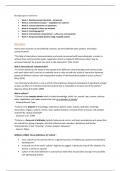Benaderingen en domeinen
• Week 1: Beeldvorming & identiteit – introductie
• Week 2: Contrastieve analyse – vergelijken van culturen
• Week 3: Cultuurrelativisme en pluralisme
• Week 4: Etnografie Cultuur en methode
• Week 5: Interlanguage ELF
• Week 6: Interculturele competenties – cultuur en communicatie
• Week 7: Responsiecollege (indien nodig, mogelijk online)
Stof week 1
Hoe kunnen mensen uit verschillende culturen, die verschillende talen spreken, met elkaar
communiceren?
“The field of intercultural communication is primarily concerned with how individuals, in order to
achieve their communication goals, negotiate cultural or linguistic differences which may be
perceived relevant by at least one party in the interaction” (Zhu, 2014)
Wat is interculturele communicatie?
“It is often defined as the study of how people from different cultural backgrounds communicate
with each other and is used as an umbrella term to refer to both the study of interaction between
people of different cultures and comparative studies of communication patterns across cultures.”
(Zhu, 2013)
“An intercultural situation is one in which cultural distance between participants is significant enough
to have an effect on interaction/communication that is noticeable to at least one of the parties.”
(Spencer-Oatey & Franklin 2009)
Wat is cultuur?
“Culture is that complex whole which includes knowledge, belief, art, morals, law, custom, and any
other capabilities and habits acquired by man as a member of society”
- Edward Burnett Tylor
“Culture is the deposit of knowledge, experience, beliefs, value, actions, attitudes, meanings,
hierarchies, religion, notions of time, roles, spatial relations, concepts of the universe, and artifacts
acquired by a group of people”
- Samovar et al., 1998
“Culture is a fuzzy set of attitudes, beliefs, behavioural norms, and basic assumptions and values that
are shared by a group of people, and that influence each member’s behaviour and his/her
interpretations of the “meaning” of other people’s behaviour”
- Spencer-Oatey
Williams (1983): three definitions of ‘culture’:
• First, culture can be used to refer to ‘a general process of intellectual, spiritual and aesthetic
development.’
• A second use of the word ‘culture’ might be to suggest ‘a particular way of life, whether of a
person, a period or a group’.
• Culture in this third definition is synonymous with what structuralists and post-structuralists
call ‘signifying practices’.
,Bourdieu on taste: Habitus is sedimented into the body
Tastes are the practical affirmation of an inevitable difference. It is no accident that, when they have to be
justified, they are asserted purely negatively, by the refusal of other tastes. In matters of taste, more than
anywhere else, all determination is negation; and tastes are perhaps first and foremost distastes, disgust
provoked by horror or visceral intolerance of the tastes of others. ‘De gustibus non est disputandum*’: not
because ‘all tastes are in nature’, but because each taste feels itself to be natural, which amounts to rejecting
others as unnatural and therefore vicious. Aesthetic intolerance can be terribly violent. Aversion to different
lifestyles is perhaps one of the strongest barriers between the classes. - Bourdieu, Pierre, and Richard (Trans)
Nice. 1995.
* In matters of taste, there can be no disputes; over de smaak valt niet te twisten
Voorbeeld analyse in de trend van ICC (Shadid 2005, p. 330)
• Media leveren een bijdrage aan negatieve beeldvorming over allochtonen en hun discriminatie in
de samenleving.
• Grote rol bij het ontstaan en verspreiden van stereotypen over sociale groepen.
– Ondervertegenwoordiging in de media
– Selectieve weergave
– Stereotype presentaties
Dichotomieën van cultuur (Shadid 2005)
Dichotomie = opdeling in twee niet-overlappende structuren of begrippen
• Westen: creatief en dynamisch
• Islamitische wereld: beperkend, levenloos en statisch
“Zo komt dan een statische, ondemocratische en achterlijke islam tegenover een moderne,
dynamische en democratische wereld te staan.”
Binaire opposities: us vs them
• Paren van tegengestelde begrippen of categorieën:
– Dag/ Nacht
– Goed/ Kwaad
– Sterk / Zwak
• Eén van de begrippen of categorieën krijgt de voorkeur:
– Man / Vrouw
– Wit / Zwart (Afro-Amerikanen zijn een “gedevalueerde” ander.)
– Us / Them (etnocentrisch)
Risico:
Het privilegiëren van de ene groep boven de andere
‘Wij-zij-deling’
• Social identity theory
– Ingroup vs outgroup
– Us versus them
De deling van de samenleving in ‘wij’ en ‘zij’
• Negatieve representatie van ‘de ander’ in combinatie met een positieve representatie van de eigen
groep.
, Rol van media
van hate spin tot peace journalism
War provides visuals and images of action. It is associated with heroism and conflict, focuses on the
emotional rather than on the rational, and satisfies news-value demands: the present, the unusual,
the dramatic, simplicity, action, personalization, and results.
A peace process is complicated; journalists demand simplicity. A peace process takes time to unfold
and develop; journalists demand immediate results. (Wolfsfeld 1997)
Hate spin absorbs the familiar concept of hate speech, or incitement, and combines it with the less
understood strategy of offense-taking or manufactured indignation. The two sides of hate spin-
incitement and offense-taking—are used by political entrepreneurs to mobilize supporters and
coerce targeted groups. (George 2017)
Actoren in de dialog
• Journalisten: faciliteren en het in scene zetten van het debat
o Wij potentiële slachtoffers, zij potentiële daders
• Vrijheidsstrijders (terroristen): “Wij doen dit namens de Islam.”
o (Wij islamieten - zij goddelozen)
• Allochtonen: “Wie zegt mij dat ik mij moet distantiëren? Ik heb niets met hen gemeen.”
o (Wij Nederlanders, al dan niet praktiserend moslim – zij terroristen)
• Nederlanders (de man op de straat): “53 procent is bang voor een terroristische aanslag van de
moslimextremisten.”
o (Wij Nederlanders, zij moslimextremisten)
Beeldvorming in de media
• Zelf- en ander-identificatie leidt tot wij-zij denken
• Ontstaan constant nieuwe wij-zij opposities
o Toont meervoudige identificaties
• Interactie met het publiek als derde partij
• Taalhandelingen:
• Verontschuldiging
• Zich moeten distantiëren/ disidentificatie
• Verantwoordelijkheid nemen
Maar: alles stroomt
• Concepten en categorieën zijn altijd in beweging
• Wat wij vandaag zien als Nederlander of Moslim kan over x jaar anders zijn
• Historische conjunctie; samenkomst van oneindig veel factoren. Wees bewust van context





